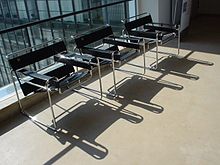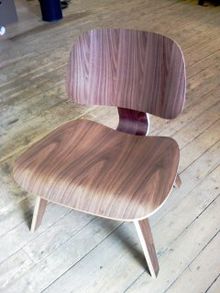- Modern furniture
-
Modern furniture refers to furniture produced from the late 19th century through the present that is influenced by modernism. It was a tremendous departure from all furniture design that had gone before it. Dark or gilded carved wood and richly patterned fabrics gave way to the glittering simplicity and geometry of polished metal. The forms of furniture evolved from visually heavy to visually light.
Contents
Influences
Prior to the modernist design movement there was an emphasis on furniture as ornament, the length of time a piece took to create was often a measure of its value and desirability. During the first half of the 20th Century a new philosophy emerged shifting the emphasis to function and accessibility. Western design generally, whether architectural or design of furniture had for millennia sought to convey an idea of lineage, a connection with tradition and history. The modern movement sought newness, originality, technical innovation, and ultimately the message that it conveyed spoke of the present and the future, rather than of what had gone before it.
Modernist design seems to have evolved out of a combination of influences: Technically innovative materials and manufacturing methods, the new philosophies that emerged from the Werkbund and the Bauhaus School, from exotic foreign influences, from Art Nouveau and from the tremendous creativity of the artists and designers of that era.
Materials
The use of new materials, such as steel in its many forms; molded plywood, such as that used by Charles and Ray Eames; and of course plastics, were formative in the creation of these new designs. They would have been considered pioneering, even shocking in contrast to what came before. This interest in new and innovative materials and methods - produced a certain blending of the disciplines of technology and art. And this became a working philosophy among the members of the Deutscher Werkbund. The Werkbund was a government sponsored organization to promote German art and design around the world. Many of those involved with it including Mies van Der Rohe, Lilly Reich and others, were later involved in the Bauhaus School, and so it is not surprising perhaps that the Bauhaus School took on the mantle of this philosophy. They evolved a particular interest in using these new materials in such a way that they might be mass produced and therefore make good design more accessible to the masses.
African and Asian culture
An aesthetic preference for the baroque and the complex was challenged not only by new materials and the courage and creativity of a few Europeans, but also by the growing access to African and Asian design. In particular the influence of Japanese design is legend: in the last years of the 19th Century the Edo Period in Japan, Japanese isolationist policy began to soften, and trade with the west began in ernest. The artifacts that emerged were striking in their simplicity, their use of solid planes of color without ornament, and contrasting use of pattern. A tremendous fashion for all things Japanese - Japonism - swept Europe. Some say that the western Art Nouveau movement emerged from this influence directly. Designers such as Charles Rennie MacIntosh and Eileen Gray are known for both their modern and Art Deco work, and they and others like Frank Lloyd Wright are notable for a certain elegant blending of the two styles.
Iconic examples of modern furniture
Marcel Breuer's Wassily Chair
This modernist creation is perhaps one of the most iconic furniture designs of all times. The Wassily Chair, also known as the Model B3 chair, was designed by Marcel Breuer in 1925-26 while he was the head of the cabinet-making workshop at the Bauhaus, in Dessau, Germany. The design of the chair is most interesting in that it is a symmetrical abstraction of wafer thin, geometric planes that appears to be suspended in space. The magic of this is sublime design is to be primarily attributed to Breuer's ingenious use of lightweight tubular steel and minimalist leather straps.
Eileen Gray side table
Designed in 1927 as a bedside table for the guest room in E-1027, the home she designed for herself (and Jean Badovici) in Cap Martin, France, the asymmetry of this piece is characteristic of her "non-conformist" design style in her architectural projects and furniture. Notably, this piece also has specific utility, as it can be adjusted such that one can eat breakfast in bed on it. Gray's sister had requested such accommodation during her visits to E-1027.
Barcelona chair
The Barcelona chair has come to represent the Bauhaus design movement. Many consider it to be functional art, rather than just furniture. Designed by Mies Van Der Rohe and Lilly Reich in 1929 for an international design fair in Barcelona, it is said to have been inspired by both the folding chairs of the Pharaohs, and the 'X' shaped footstools of the Romans, and dedicated to the Spanish royal family.
Noguchi coffee table
Isamu Noguchi 1904 - 1988 was a sculptor, architect, furniture and landscape designer. Half American, half Japanese, he is famous for his organic modern forms. The Noguchi table - has become famous for its unique and unmistakable simplicity. Refined and at the same time natural, it is one of the most sought after pieces associated with the modern classic furniture movement.
Chronology
Chronologically the design movement that produced modern furniture design, began earlier than one might imagine. Many of its most recognizable personalities were born at the end of the 19th or the very beginning of the 20th centuries.
- Marcel Breuer 1902–1981
- Ludwig Mies van der Rohe 1886–1969
- Eileen Gray 1878–1976
- Le Corbusier 1887–1965 (born Charles Edouard Jeanneret)
- Lilly Reich 1885–1947
- Walter Gropius 1883–1969
They were teaching and studying in Germany and elsewhere in the 1920s and 30s. At among other places the Bauhaus school of art and architecture. The furniture that was produced during this era is today known as "Modern Classic Furniture" or "Mid Century Modern".
Both the Bauhaus School and the Werkbund, had as their specific creative emphasis the blending of technology, new materials and art.
Transitional furniture
Obviously not all furniture produced since this time is modern, for there is still a tremendous amount of traditional design being reproduced for today's market and then of course there is also an entire breed of design which sits between the two, and is referred to as transitional design. Neither entirely modern or traditional, it seeks to blend elements of multiple styles. It often includes both modern and traditional as well as making visual reference to classical Greek form and / or other non western styles (for example: Tribal African pattern, Asian scroll work etc).
Modern to contemporary
Today contemporary furniture designers and manufacturers continue to evolve design. Still seeking new materials, with which to produce unique forms, still employing simplicity and lightness of form, in preference to heavy ornament. And most of all they are still endeavoring to step beyond what has gone before to create entirely new visual experiences for us.
The designs that prompted this paradigm shift were produced in the middle of the 20th century, most of them well before 1960. And yet they are still regarded internationally as symbols of the modern age, the present and perhaps even the future. Modern Classic Furniture became an icon of elegance and sophistication.
References
External links
Wikimedia Foundation. 2010.


